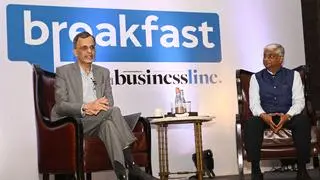Painting a rosy picture of the economy, the mid-year economic analysis has forecast a GDP growth of 7-7.5 per cent this fiscal.
This is however lower than the 8.1-8.5 per cent growth projected in February in the Economic Survey.
“With the reforms process gathering momentum, along with low inflation which should help in keeping a benign interest rate regime, one can expect the full-year growth of real GDP to be in the range of 7-7.5 per cent,’’ the mid-year economic analysis report tabled in Lok Sabha said.
The mid-year economic analysis highlighted that the Indian economy this fiscal was being powered only by private consumption and government investment and that the economy was doing "remarkably well".
"The remarkable thing about 2015-16 growth performance is that it continues to be as strong as it is given the weakness of exports (because of declining world markets) and private investment," the report said.
The difference with 2014-15 is that the decline in exports has been offset by higher consumption and public investment, it added.
Challenges remain
While noting that the economy has progressed well, the report has however highlighted that challenges remain.
On the positive side, macroeconomic stability has improved considerably, cushioning the economy against possible adverse external shocks, including a decision by the US Federal Reserve to increase interest rates. The real economy is showing signs of recovery.
At the same time, the improvement in growth has been uneven, powered only by private consumption and public investment.
For sustainable and rapid medium term growth, private sector investment and exports need to revive, the report added.
Policy re-assessment
India needs to carefully "re-assess" both fiscal and monetary policy stances in the context of mixed demand outlook going forward and declining nominal GDP growth, the report said.
This must be done to ensure that an appropriate balance is truck between the short-term need to spur demand, especially private investment and exports, and the longer term needs of preserving fundamental macroeconomic stability.
To move India rapidly to its medium term growth trajectory, supply side reforms and demand management will be essential, the report said.
Supply side reforms will help restart the private investment cycle, notably through recognition and resolution of the balance sheet problems of firms and banks as well as creating a clean and favorable tax environment through implementation of Goods and Services Tax (GST) and planned corporate tax reforms, it added.
GST logjam
Reacting to the mid-year economic analysis, Jayant Sinha, Minister of State for Finance, said that the economic growth forecast (7-7.5 per cent) had to be pruned largely due to a sharp contraction in exports due to decline in world demand.
The next year (2016-17) will see some improvement in exports on the back of recovery in US economy, Sinha told reporters.at Parliament soon after the report was tabled in the Lower House.
Sinha also expressed confidence that the fiscal deficit target of 3.9 per cent for the current fiscal would be met.
He also lashed out at the Congress for not supporting the introduction of Goods and Services Tax (GST) and thereby affecting the growth prospects of the country.
Had the Congress come forward to support the Constitutional Amendment Bill, the country would have easily looked at the growth level of 8 per cent next fiscal, Sinha said.
The mid-year economic analysis has highlighted that the real GDP growth next year would not be significantly greater than the growth this year This would be the case unless supply side reforms provide an impetus to growth, the report added.








Comments
Comments have to be in English, and in full sentences. They cannot be abusive or personal. Please abide by our community guidelines for posting your comments.
We have migrated to a new commenting platform. If you are already a registered user of TheHindu Businessline and logged in, you may continue to engage with our articles. If you do not have an account please register and login to post comments. Users can access their older comments by logging into their accounts on Vuukle.